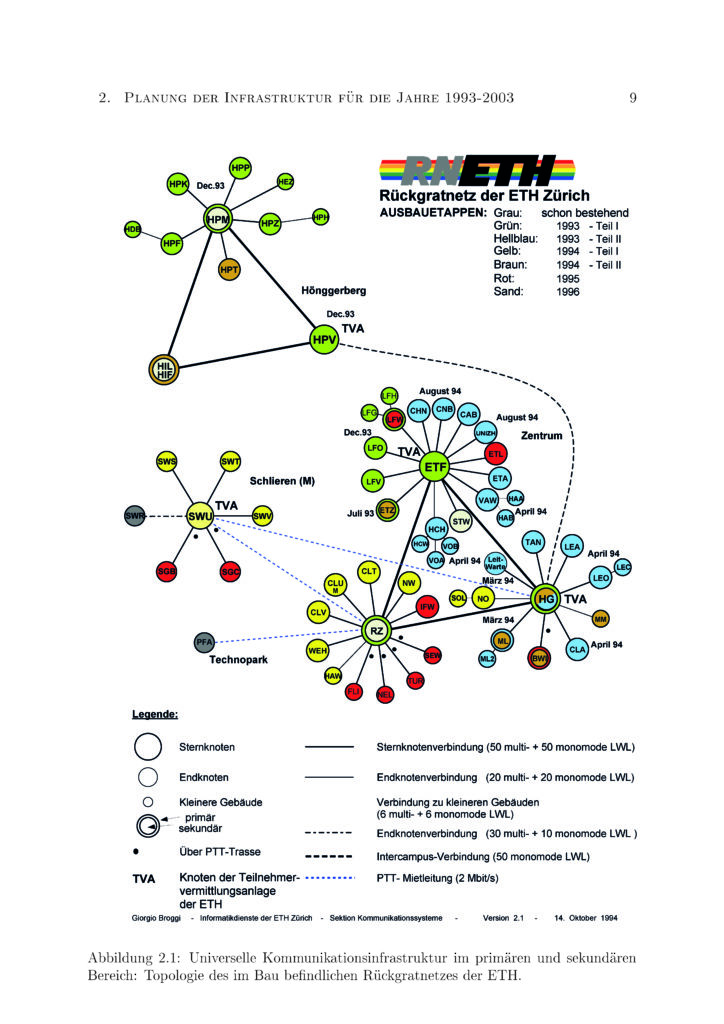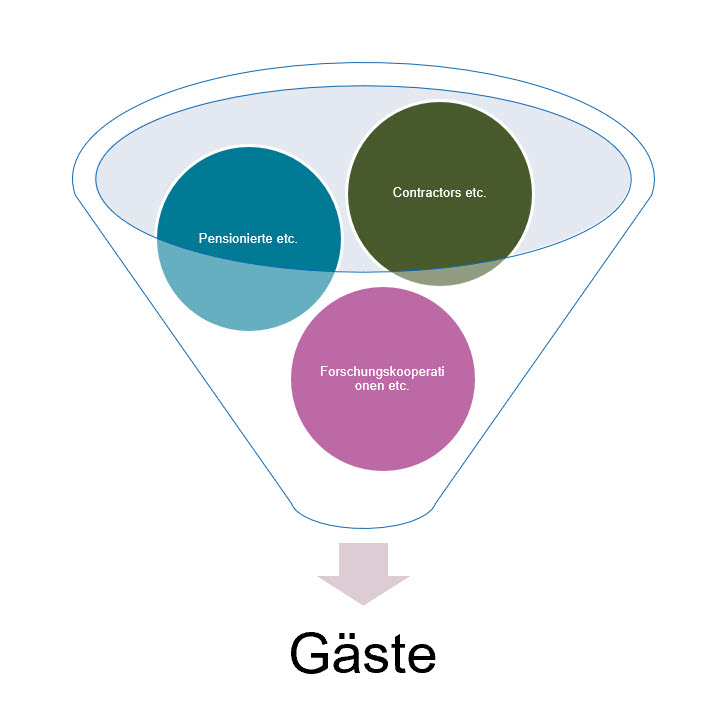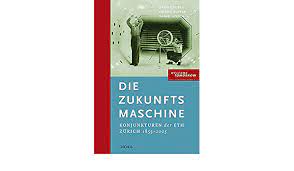Giorgio Broggi looks back on his 30th anniversary
IT Services congratulates Giorgio Broggi on his anniversary at ETH!

After deciding not to pursue an academic career any longer, I was hired by IT Services (ITS), Communication Systems Section, in 1992.
Communications infrastructure
The pioneering days of physical networks were just over, and I was able to take on the task of setting up the new communication infrastructure. The biggest challenge was the design and construction of the physical backbone network of ETH, which connects with optical fibres all ETH buildings on the two campuses Zentrum and Hönggerberg. At the time, my choice of a ring-of-stars topology could only be realised in Hönggerberg in terms of active components (the cables of two ring routes ran in parallel in the same channel for years). In the more recent past, however, the topology was also implemented physically. Planning and construction of universal building cablings was no less complex. I was tasked with representing ETH in national committees for the development of the new Swiss standard and with writing the (supplementary) internal ETH guidelines. In the search for suitable communication rooms, I had to walk through all ETH buildings, room by room. On the organisational level, the programme for universal cabling of all ETH buildings had to be conceived and set up in collaboration with the Federal Office for Buildings. This was the case because ETH Zurich was assigned to the office’s building district 4 at the time. These efforts were very fruitful: in from the timespan 1994–1996, all the main ETH properties had been wired and about 20,000 UTP connections put into operation.

Data communications and telephone services
Telephone services came to ITS according to the recommendations of the Merging Data Communications and Telephone Services project. Previously, telephone services was part of “Technischer Dienst”, which was merged with the “Hausdienst” within the framework of the same project and transferred to Facility Management (“Abteilung Betrieb”). Through my involvement in the project, I was able to start working more directly with the then Interim Head of IT Services, Andreas Dudler. When Andreas Dudler took over as Head of ITS, the position of Head of Betriebsinformatik (BI) became vacant and I was able to successfully apply for it. I took up the new position in early June 1996 and with it the management of approximately 12 employees. So, I began my 25 years of work for the central IT of ETH Zurich.
What I am going to describe in the following paragraphs should be understood as the collective achievement of all employees of BI and later of ITS Software Services (SWS). However, I will only mention former employees by name: they should be considered a proxy for all the colleagues who have shown such a high commitment over this long period of time.
History of central information systems and IT workstations
Not only for the younger generation, but also for the 50-year-old, it is really difficult to imagine what the central information systems and the IT equipment of the Central Bodies were back then. Both were the responsibility of BI. In the area of education, the second, command-line-oriented generation of applications (LBA) was in operation (the first, punch-card-based generation had already been created in the 1960s). For the student administration, the Course Catalogue and exam planning, separate applications were in operation on 32-bit virtual memory system (Data General), based on a relational database (Mimer). Only elements of the course catalogue were available via the web. A Cobol application was in use for finance. For human resources, there was a local Mimer-based solution (PerETH), while salaries were processed centrally by the Federal Personnel Office (PERIBU). The IT equipment of the workstations of the Central Bodies consisted of a few dozen Macs and a similar number of PCs, some networked with broadband (KomETH) and some with Ethernet, with local small-scale Filemaker, 4th-Dimension and MS Access solutions for the purposes of administrative data processing.
Identity management
The introduction of the first-generation ETH card (1998), which was to replace the separate paper ID cards for students and staff, gave me the opportunity to tackle one of the fundamental problems of administrative data management: identity management. At that time, it was indeed possible to tell on an ongoing basis how many students, how many lecturers and how many employees ETH Zurich had. Yet, because of the separate information systems handling the three groups, the number of ETH members could only be determined periodically and offline, e.g., for the purposes of the Federal Statistical Office. Thanks to the new approach “one record per person, relationships as attributes”, the People Database (PDB) was born. A couple of years later, this method made the pioneering achievement of “nethz” possible, which, in turn avoided the time-consuming deployment of meta-directories. However, the introduction of the PDB and of the ETH card would never have succeeded without the meticulous, extremely laborious data migration carried out by Alfred Sohm, the author of the new data model and administrator of the (Oracle) database. In 1997, a new architecture was chosen for the PDB/ETH card and for the simultaneous implementation of the new application for student administration (LisETHpro). It was based on a central database, with Java web clients for students and lecturers and PowerBuilder clients on MS Windows for the back-office processes.
IT workstations at the Central Bodies
The choice of the MS Windows platform gave me the opportunity to address a second fundamental issue: set-up and standardisation of the workstations of the Central Bodies (CB). By the end of 1999 under the leadership of Candan Alaygüvenci — and later Domenica Wieghardt and Thomas Widmann –, a new IT infrastructure for more than 400 workplaces was created (and not without resistance, even within the division). These systems were connected to the universal cabling and integrated into a Windows domain with central policies and dedicated servers. A supporter group (ZO-Support, initially consisting of three people) as well as a user organisation (Forum of the IT coordinators of the Central Bodies) were formed and the users were trained in the usage of the new infrastructure across the board.
In 2000, under the leadership of Peter Wegmann, ITS’s first MS Exchange installation was set up on this infrastructure. Shortly afterwards (2002), originally on the initiative of Danuta Rogalski, ITS’s first software distribution and installation automation solution (CCM) and the first remote support procedure (using VCM) were introduced. I handed over responsibility for the CBs’ workplaces to the new Service Delivery division at the end of 2010.
New IT needs and challenges
At the end of the 1990s, two new, external factors set the ETH IT landscape in motion, securing management commitment and funding for the corresponding projects: LereVe and the Bologna-Sorbonne Reform. In order for the dream of being managed with a performance mandate and accounting independence (“Leistungsauftrag und rechnungstechnische Verselbständigung”, hence LereVe) to become reality, ETH had to introduce SAP, as stipulated by the Federal Administration. In the same time span, a new educational application system (Lehrbetriebsapplikation, LBA) had to be implemented for the new, tiered curricula. Funding was not an issue (millions were made available); yet hard deadlines were put in place, which, in most cases, we managed to meet.
SAP implementation project
The first SAP deployment project was led by the Finance and Human Resources Departments. ITS assumed responsibility for the Basic Components and SW development, first in the project and later within the Competence Centre SAP (CCSAP). Among the many and complex challenges of the SAP implementation was the use of the PDB as the master system for the personnel records since SAP at that time was a closed system with few connection options. The first version of the interface could only be set up thanks to the support of Andreas Dudler and the involvement of SAP Waldorf: this way, however, the principle of central identity management could be safeguarded. The choice of the cameralistic financial model was made against the opinion of IT Services and led to significant bottlenecks in the following years. The project was completed on schedule (1998) in the area of finance and controlling, one year late for human resources.
Bologna Reform
In accordance with the Bologna Declaration, ETH Zurich had to reorganise its curricula by 2004: tiered studies, ECTS credits and new names for al academic degrees had to be introduced. This was a major challenge both in terms of organisation and of information technology. Under pressure and with a clear individual software strategy, the new LBA system was developed over only a few years. By 2005, thanks also to Arlette Gaillard’s tireless and extremely competent technical coordination, student administration, management of teaching, performance assessments and interaction with students and lecturers had been realized in the new system with a sufficient degree of completeness, in time for the implementation of the Bologna Reform.
OIS
Parallel to setting up the LBA, I was given the task of defining the overall structure of the ETH Operational Information System (OIS), of which two essential components, namely LBA and SAP, were already predetermined. Since the “process islands” of ETH Zurich (education, finance, human resources, real estate management, logistics) were well established and documented, and were set up relatively independently of one another, I outlined the OIS as a best-of-breed composite of two– and three-tier database applications that could have been custom or off-the-shelf products. Using a few narrow interfaces between components, the OIS ensures the largely redundancy-free management of the central data, whereby the definition of the master systems is determined by the data sovereignty landscape. The OIS was essentially built in parallel to the LBA under the leadership of Alfred Sohm and is still technically and operationally very stable. I was able to validate the OIS model in 2005/2006 during a sabbatical leave at Oxford University, Imperial College in London and the University of Edinburgh.
With the introduction and connection of the applications for real estate management (2005-2009, led by Paul Jesenak), which are based on the standard facility management solution Planon, OIS was able to support the most important process islands of ETH.
A less well-known but important component of OIS is the organisational database (OrgDB) in which the master data on the ETH’s organisational structure and the aggregation levels for controlling are managed. Incidentally, with the OrgDB project, I had the pleasuee to begin my collaboration with Dieter Wüest, later Head of Academic Services, a collaboration that proved the most important and also the most pleasant in my ETH career. However, I was not able to realise my idea of positioning OrgDB as a repository of all roles and functions and their occupancies, in order to use this data for the provisioning of the IAM system for the purposes of an ETH-wide access management. The lack of clear ETH-wide governance with a consistent definition of roles and responsibilities – and also the lack of interest on the part of the then General Secretariat – made this venture just as ill-fated as my attempts to convince the relevant division heads to use the Ivy workflows not only for their internal processes, such as the so-called salary round, but also to support overarching processes.

ETHIS
The introduction of the ETH information system ETHIS in turn was very successful, thanks to Markus Knaus, Adrian Fischer and all the CCSAP colleagues in the divisions Controlling, HR and IT Services. Thanks to the new financial regulations secured by Dr Robert Perich, it was possible to define a single access management system for Finance and Human Resources and establish the principles of an enterprise portal. – This wouldn’t have been possible without Markus’s clear vision and far-sighted planning.
ITS realignment 2011-2015
When Reto Gutmann took over as director (2011), IT Services was reorganised according to the standard ITIL model. BI was disbanded, basic technologies were moved to Basic Services (ITS BD) and the remaining areas of BI, together with the groups nethz and Web Content Management (WCMS) from ITS BD, formed the new division ITS Software Services (ITS SWS), which I took over at the beginning of 2012.
SWS was now offering services also to the education and administrative units of the departments. In the following years, several applications were realised for them, such as Praktikum/Praxis (Internship/Practice), Doktorierende-Bewerbung (Doctoral Application) and Hilfsassistierendentool (Junior Assistant Tool).
Thanks to the support of the new director, SAP development was considerably strengthened and became an independent group, of which I am the head. This growth enabled ITS to participate much more substantially in the refine project. which a complete re-implementation of ETH Zurich’s financial accounting was to take place. The new SAP deployment was carried out using the new possibilities of SAP S/4HANA and according to the established accounting standards.
The implementation of the new WCMS at ETH Zurich as part of the Web Relaunch project had experienced considerable difficulties, which were addressed with a grass-roots reorganisation of the project team, from which the current WCMS group emerged.
In this phase, in addition to the realisation of further applications for the support of central processes at ETH Zurich (e.g., the PROFIS professorship planning tool, KDB contact database, IKB international knowledge base), renewed attention was paid to application security, which led to the adoption of security frameworks and the deployment of scanning tools.
Interim management of ITS
Shortly before Reto Gutmann’s departure at the beginning of 2016, Prof Ulrich Weidmann entrusted me with the management of ITS during the search for Reto’s successor. This phase extended itself over several months. In addition to continuing ongoing projects and consolidating internal processes, I prepared and accompanied the periodic evaluation of ITS together with Dordaneh Arangeh. The evaluation takes place every seven years and is carried out as a peer review. Other focal points of my work as director were the formation, in cooperation with Armin Wittmann, of ITS’s new integral security organisation, the creation of the position of Chief IT Security Officer (CITSO) as well as preparatory work for the introduction of the specialist communities and careers. I was also happy to support Dordaneh’s preparationsfor the Project Management Office (PMO) and for the expansion of Service Management.
As Head of SW Services, I was simultaneously involved in the evaluation of the “long-term perspectives for IT support of central processes for education at ETH Zurich”, which was also carried out as a peer review. The evaluation group confirmed the quality and sustainability of our LBA concepts and technologies and identified the main risks in the retirement of the authors of the system.
refine and IAM
By coincidence, the stat of work of Rui Brandao at the beginning of November 2016 and the acceptance of the LBA evaluation report by the Executive Board happened on the same day. Rui’s assumption of the directorship ensured space for me to accompany the realisation phase of the two ongoing, important projects of SW Services: refine and IAM.
refine was essentially completed by the end of 2018 and can be considered a complete success from the perspective of the basic components and SW-development, which would not have been possible without the competence, commitment and self-reliance of the ITS employees involved. This was also documented in the project evaluation.

IAM was a thorny project in every respect marked by all kinds of difficulties, some of which caused by misjudgments on my part. However, just the fact that the new IAM system went live in April 2019 after a 100-hour work week and had no significant errors or instabilities since the following autumn should be accredited to the project manager and his team. They have shown extraordinary perseverance and loyalty. Incidentally, significant lessons about tendering procedures were learned out of the (bad) experiences within this and other projects. The opportunities for interaction with suppliers are now much better cared for, and the role of the proof-of-concept phase has been significantly expanded.
Other significant projects of the last four years are as follows:
- the implementation of the new IT support for ETH’s internal funding programmes (eResearch). This project is being realised with the use of SaaS, after a previous individual development being discontinued.
- the Online Communication 22 programme, which ensures the project-like continued development of the WCMS environment.
- the development of IT process support for the Services division (Campus Services since 1 January 2022).
Since 2019, I have been involved in the “Berechtigungsmanagement für Gäste” (Authorisation of Guests) project, which will settle the long-standing pending issue of regulating the usage of ETH services by non-affiliates. On the other hand, the ever-increasing disproportion between resources (especially FTE) and customer projects has, if not stopped, then at least increasingly slowed down the ongoing internal updating of tools and methods.

The year 2022
It’s crept up on us slowly – the year 2022 – and with it, the transfer of SW Services to the new Applications division (ITS APPS) and the handover of responsibility for ETH Zurich’s Central Systems to Dimi Fazzone. I am very pleased to have an all-round qualified, highly professional and experienced successor who will, among other things, help the fourth generation of LBA to be established on the emerging Digital Campus. Hopefully he will also be allowed to build information systems that take digitalisation beyond the boundaries of the process islands and be responsible for projects that no longer roam about like loners; but are solidly and sustainably managed in a central ETH portfolio. I also hope for him, of course, that he won’t always have to live with the total disproportion between tasks and resources, which I have tried to counteract since 2006, in vain …
But this is not Dimi’s blog, so back to my life at ITS. At the end of April I will hand over management of the SAP group to Markus Oswald, and in mid-June I expect to hand over the IT sub-management of the guest project to Andy Jost. My last day of work will be 22 June 2022.
In conclusion? In these good 25 years as division head, I have tried, without complacency and with minimal overhead, to extract the maximum for the support of teaching, knowledge transfer and the national tasks of the school by using the resources and the time at my disposal, while knowing all too well that support was, and still is, the raison d’être of BI/SWS in the first place. The extent to which I have succeeded is, of course, not for me to judge…
“The Future Machine” with the original OIS scheme

See also Figure 2 from the book “Die Zukunftsmaschine, Konjunkturen der ETH Zürich 1855-2005” (The Future Machine, Economic Trends at ETH Zurich, 1855-2005) by historians David Gugerli, Patrick Kupper and Daniel Speich
erstellt am
in News


